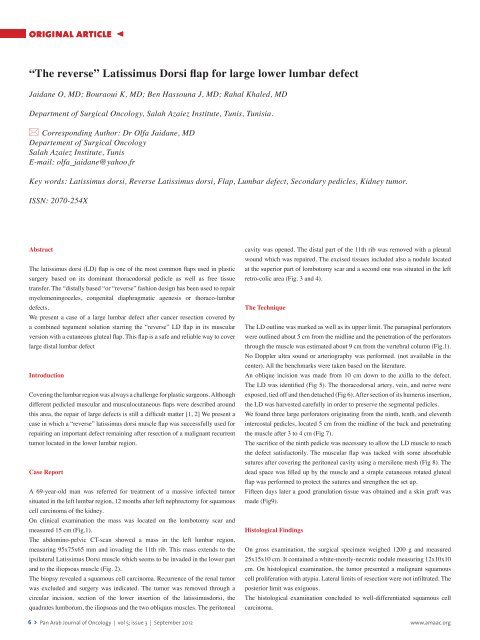Pan Arab Journal of Oncology - Arab Medical Association Against ...
Pan Arab Journal of Oncology - Arab Medical Association Against ...
Pan Arab Journal of Oncology - Arab Medical Association Against ...
You also want an ePaper? Increase the reach of your titles
YUMPU automatically turns print PDFs into web optimized ePapers that Google loves.
original article <<br />
“The reverse” Latissimus Dorsi flap for large lower lumbar defect<br />
Jaidane O, MD; Bouraoui K, MD; Ben Hassouna J, MD; Rahal Khaled, MD<br />
Department <strong>of</strong> Surgical <strong>Oncology</strong>, Salah Azaiez Institute, Tunis, Tunisia.<br />
Corresponding Author: Dr Olfa Jaidane, MD<br />
Departement <strong>of</strong> Surgical <strong>Oncology</strong><br />
Salah Azaiez Institute, Tunis<br />
E-mail: olfa_jaidane@yahoo.fr<br />
Key words: Latissimus dorsi, Reverse Latissimus dorsi, Flap, Lumbar defect, Secondary pedicles, Kidney tumor.<br />
ISSN: 2070-254X<br />
Abstract<br />
The latissimus dorsi (LD) flap is one <strong>of</strong> the most common flaps used in plastic<br />
surgery based on its dominant thoracodorsal pedicle as well as free tissue<br />
transfer. The “distally based “or “reverse” fashion design has been used to repair<br />
myelomeningoceles, congenital diaphragmatic agenesis or thoraco-lumbar<br />
defects.<br />
We present a case <strong>of</strong> a large lumbar defect after cancer resection covered by<br />
a combined tegument solution starring the “reverse” LD flap in its muscular<br />
version with a cutaneous gluteal flap. This flap is a safe and reliable way to cover<br />
large distal lumbar defect<br />
Introduction<br />
Covering the lumbar region was always a challenge for plastic surgeons. Although<br />
different pedicled muscular and musculocutaneous flaps were described around<br />
this area, the repair <strong>of</strong> large defects is still a difficult matter [1, 2] We present a<br />
case in which a “reverse” latissimus dorsi muscle flap was successfully used for<br />
repairing an important defect remaining after resection <strong>of</strong> a malignant recurrent<br />
tumor located in the lower lumbar region.<br />
Case Report<br />
A 69-year-old man was referred for treatment <strong>of</strong> a massive infected tumor<br />
situated in the left lumbar region, 12 months after left nephrectomy for squamous<br />
cell carcinoma <strong>of</strong> the kidney.<br />
On clinical examination the mass was located on the lombotomy scar and<br />
measured 15 cm (Fig.1).<br />
The abdomino-pelvic CT-scan showed a mass in the left lumbar region,<br />
measuring 95x75x65 mm and invading the 11th rib. This mass extends to the<br />
ipsilateral Latissimus Dorsi muscle which seems to be invaded in the lower part<br />
and to the iliopsoas muscle (Fig. 2).<br />
The biopsy revealed a squamous cell carcinoma. Recurrence <strong>of</strong> the renal tumor<br />
was excluded and surgery was indicated. The tumor was removed through a<br />
circular incision, section <strong>of</strong> the lower insertion <strong>of</strong> the latissimusdorsi, the<br />
quadrates lumborum, the iliopsoas and the two obliquus muscles. The peritoneal<br />
6 > <strong>Pan</strong> <strong>Arab</strong> <strong>Journal</strong> <strong>of</strong> <strong>Oncology</strong> | vol 5; issue 3 | September 2012<br />
cavity was opened. The distal part <strong>of</strong> the 11th rib was removed with a pleural<br />
wound which was repaired. The excised tissues included also a nodule located<br />
at the superior part <strong>of</strong> lombotomy scar and a second one was situated in the left<br />
retro-colic area (Fig. 3 and 4).<br />
The Technique<br />
The LD outline was marked as well as its upper limit. The paraspinal perforators<br />
were outlined about 5 cm from the midline and the penetration <strong>of</strong> the perforators<br />
through the muscle was estimated about 9 cm from the vertebral column (Fig.1).<br />
No Doppler ultra sound or arteriography was performed. (not available in the<br />
center). All the benchmarks were taken based on the literature.<br />
An oblique incision was made from 10 cm down to the axilla to the defect.<br />
The LD was identified (Fig 5). The thoracodorsal artery, vein, and nerve were<br />
exposed, tied <strong>of</strong>f and then detached (Fig 6). After section <strong>of</strong> its humerus insertion,<br />
the LD was harvested carefully in order to preserve the segmental pedicles.<br />
We found three large perforators originating from the ninth, tenth, and eleventh<br />
intercostal pedicles, located 5 cm from the midline <strong>of</strong> the back and penetrating<br />
the muscle after 3 to 4 cm (Fig 7).<br />
The sacrifice <strong>of</strong> the ninth pedicle was necessary to allow the LD muscle to reach<br />
the defect satisfactorily. The muscular flap was tacked with some absorbable<br />
sutures after covering the peritoneal cavity using a mersilene mesh (Fig 8). The<br />
dead space was filled up by the muscle and a simple cutaneous rotated gluteal<br />
flap was performed to protect the sutures and strengthen the set up.<br />
Fifteen days later a good granulation tissue was obtained and a skin graft was<br />
made (Fig9).<br />
Histological Findings<br />
On gross examination, the surgical specimen weighed 1200 g and measured<br />
25x15x10 cm. It contained a white-mostly-necrotic nodule measuring 12x10x10<br />
cm. On histological examination, the tumor presented a malignant squamous<br />
cell proliferation with atypia. Lateral limits <strong>of</strong> resection were not infiltrated. The<br />
posterior limit was exiguous.<br />
The histological examination concluded to well-differentiated squamous cell<br />
carcinoma.<br />
www.amaac.org









